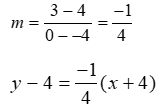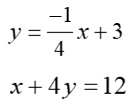Linear equations contain two variables and when we plot all the (x,y) pairs that make the equation for a line.
The formula for Standard Form is:
![]()
Here, A, B and C are real numbers and A≠ and B≠0.
Since the slope of a vertical line is undefined we don’t write the equation of a vertical line using either the slope-intersect form or the point-slope form. But we can use the standard form to express vertical lines.
To find where the line crosses each axis, let the other value be zero.
- If y is zero, we have Ax = C, C/A is the x-intercept.
- If x is zero, we have By = C, C/B is the y-intercept.
- − A/B is the slope.
Using the x-intercept and/or y-intercept as a starting point, you can use the slope to graph more points on the line of the equation.
Write an equation of the line in STANDARD/GENERAL FORM using the information given: m=2 and (3, -2)
Start with Point-Slope Form

Now put into slope-intercept form
![]()
Now put into the general form:

Leading negatives are not recommended. Therefore, change all the signs of each term
![]()
Write an equation of the line in STANDARD FORM using the information given: (-4, 4) and (0, 3)
Start with Point-Slope Form

Now put into slope-intercept form
![]()
Now put into Standard form

The process of simplifying any type of line equations to the general form is as follows:
- Do all the possible algebraic operations ( multiplication division addition and subtraction)
- Find the determinant in case of two-point form
- evaluate all the trigonometric ratios in the case of normal form
- eliminate the parameter in case of two intercept form and slope-intercept form
- shift all the gums on one side of the equation
- Arrange the terms by algebraic operations and present them in this style
| Equation form | Equation | Notes |
| Slope-intercept | y = mx + b | m is the slope.
b is the y-intercept. |
| Point slope | m is the slope and (x1, y1) is a point on the line | |
| Normal form | p is the perpendicular from the origin to the line and α is the angle between this perpendicular and the x-axis. | |
| Intercept form | a= x-intercept and b= y-intercept | |
| Parallel to axis | Vertical: x=a and Horizontal y=b | a= x-intercept and b= y-intercept |
| Two-point form | The line passes through A (x1, y1) and B (x2, y2) | |
| Standard form | A is positive. A, B and C are real numbers and A≠ and B≠0. |